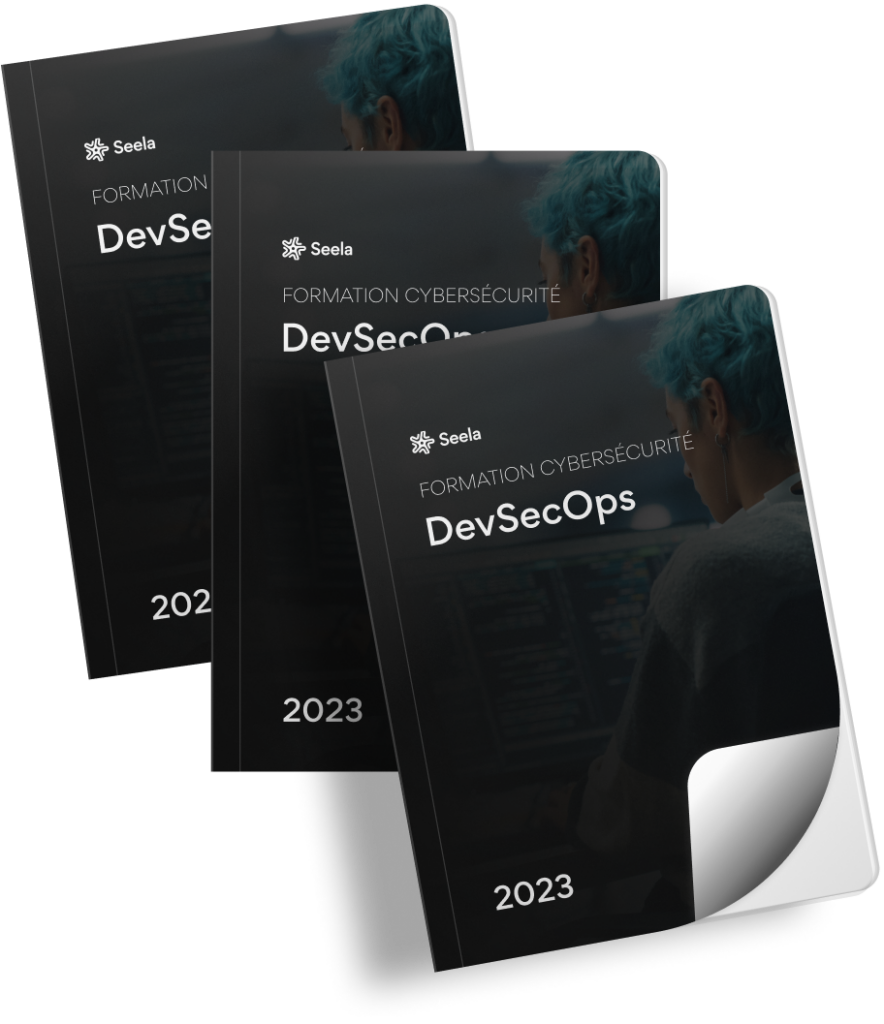Vous aimez résoudre des problèmes complexes ? Vous aimez travailler avec la technologie, le code et la programmation informatique ? Vous êtes créatif et rigoureux dans votre approche de la résolution de problèmes ? Devenez un développeur de solutions de sécurité.

Formation DevSecOps avec CyberTraining
100% en ligne
Théorie & Pratique
Personnalisé par niveau

Plateforme de formation cyber
Suivez une formation spécifique au métier de DevSecOps, adaptée à votre rythme et votre niveau.
1
Introduction à la cybersécurité
20 leçons – 10,5 h
3
La virtualisation
27 leçons – 11 h
5
Operating System
18 leçons – 6 h
7
Identity Access Management
2 leçons – 3,5 h
9
Entraînement
45 leçons – 18 h
2
4
Les couches réseau
19 leçons – 6,5 h
6
Le firewalling
11 leçons – 5 h
8
Cryptologie
3 leçons – 2,5 h
1
Introduction à la cybersécurité
20 leçons – 10,5 h
2
3
La virtualisation
27 leçons – 11 h
4
Les couches réseau
29 leçons – 11 h
5
Operating System
18 leçons – 6 h
6
Le firewalling
11 leçons – 5 h
7
Identity Access Management
2 leçons – 3,5 h
8
Cryptologie
3 leçons – 2,5 h
9
Entraînement
45 leçons – 18 h
Retrouvez le détail complet de tous les cours dispensés dans cette formation DevSecOps

Leçons clés
Mis à jour : 25/11/2022
Délais d’accès au service
+ 75h
De cours
18h
D’entraînement

Objectifs

Connaissances Préalables Conseillées

Test de positionnement
En 1ʳᵉ étape de votre parcours, vous réalisez un test de positionnement d’une heure qui donnera votre point de départ de la formation. Ce parcours est découpé en 2 niveaux :

Pratique & entrainement
Afin d’approfondir votre connaissance et assurer l’assimilation des nouvelles notions acquises, vous vous exercerez sur des cas pratiques tout au long de votre formation.
En format TD, TP ou CTF, vous appliquerez vos nouvelles connaissances acquises lors d’un cas pratique avec une mise en situation réelle sur la CyberRange.
18 heures d’entraînement disponibles dans ce parcours.
Qu’est-ce qu’un DevSecOps ?
Le DevSecOps est un développeur de solutions de sécurité qui est chargé de mettre en œuvre des fonctions de sécurité dans les applications et les systèmes. Ils utilisent des langages de programmation comme C++ ou Java et doivent avoir une bonne compréhension du fonctionnement des ordinateurs et de l’interaction des utilisateurs avec eux. Ils mettent en œuvre la méthode DevSecOps.
Un programme DevSecOps est un ensemble de processus, d’outils et de pratiques qui aident les équipes de développement à collaborer avec des professionnels de la sécurité de l’information pour créer des applications sécurisées. Il permet aux développeurs d’écrire du code sécurisé dès le début et de surveiller en permanence les vulnérabilités en temps réel. L’objectif de DevSecOps est de créer des logiciels plus rapidement en réduisant les risques et en améliorant la qualité grâce à la collaboration entre les développeurs et les professionnels de la sécurité informatique.
Les missions du DevSecOps incluent l’analyse et la prise en compte des besoins de sécurité et du contexte des menaces, la participation à la définition des spécifications générales de la solution de sécurité, la réalisation de l’analyse technique et de l’étude détaillée de la solution de sécurité, la planification et la conduite des différents projets de développement de solutions de sécurité, le développement de solutions de sécurité, la réalisation de tests pour s’assurer que les solutions de sécurité répondent aux exigences de protection ou de détection, la contribution à l’implémentation de la solution ou du produit dans une architecture logicielle et le test, et l’assurance de la maintenance corrective et évolutive des solutions de sécurité.
💡 En résumé :
Développement
Qualification
Maintenance
Collaboration avec des équipes de développement : En travaillant en étroite collaboration avec les équipes de développement, les DevSecOps peuvent contribuer à la création de logiciels plus sécurisés dès le début du processus de développement.
Amélioration de la qualité du logiciel : En intégrant la sécurité dès le début du processus de développement, les DevSecOps peuvent aider à réduire les risques de vulnérabilités et à améliorer la qualité globale du logiciel.
Possibilité de travailler sur des projets passionnants : Les DevSecOps ont la possibilité de travailler sur des projets de développement de logiciels de haute qualité et de contribuer à la création de produits innovants.
Compétences en demande : La demande pour des professionnels qualifiés en sécurité informatique est en constante croissance, ce qui signifie que les DevSecOps peuvent avoir de bonnes perspectives de carrière.
Opportunités de développement de carrière : Les DevSecOps peuvent évoluer vers des postes de gestion ou de leadership dans le domaine de la sécurité informatique, ou encore poursuivre des études avancées dans ce domaine.
Si vous êtes débutant et que vous souhaitez commencer dans le domaine de la cybersécurité et du hacking, nous vous recommandons de commencer par CyberTraining, notre plateforme de formation en ligne. CyberTraining est conçu pour vous apprendre les concepts fondamentaux de la cybersécurité à travers des leçons interactives et des exercices pratiques. Vous découvrirez comment fonctionnent les attaques informatiques et comment les prévenir en mettant en pratique les techniques apprises.
Avec CyberTraining, vous pouvez développer vos compétences en cybersécurité à votre propre rythme et suivre des parcours de formation en profondeur. Après avoir terminé les leçons de CyberTraining, vous serez prêt à passer à BattleH4ck, notre plateforme de CTF qui vous permettra de tester et de développer vos compétences en sécurité informatique en résolvant des défis passionnants. Rejoignez CyberTraining pour commencer votre parcours de formation en cybersécurité et devenir un expert en sécurité informatique.
Pour commencer votre formation DevSecOps, vous pouvez télécharger le programme sur la plateforme de formation CyberTraining. Les programmes de formation sont conçus pour former tous les profils techniques aux compétences professionnelles du métier de DevSecOps. La formation est entièrement en ligne, personnalisée par niveau et contient des leçons sur des sujets tels que l’introduction à la cybersécurité, la virtualisation, le système d’exploitation, l’Identity Access Management et l’entraînement.
Vous commencerez par un test de positionnement pour calibrer le niveau de votre parcours.
Le parcours de formation DevSecOps est découpé en deux niveaux : débutant (109 heures) et intermédiaire (89 heures).
En première étape de votre parcours, vous réalisez un test de positionnement d’une heure qui donnera votre point de départ de la formation. Tout au long de votre formation, vous vous exercerez sur des cas pratiques pour approfondir votre connaissance et assurer l’assimilation des nouvelles notions acquises.
Oui, CyberTraining propose des réductions aux étudiants. Si vous êtes étudiant, vous pouvez bénéficier d’une réduction de -30% sur votre abonnement à CyberTraining. Il vous suffit de fournir une preuve de votre statut d’étudiant pour profiter de cette réduction exclusive à l’adresse student@seela.io
En vous abonnant à CyberTraining en tant qu’étudiant, vous aurez accès à toutes les fonctionnalités de la plateforme de formation en cybersécurité.
Notions de base sur les systèmes d’exploitation :
Notions de base sur les réseaux :
Utilisation des outils informatiques :
Gestion des périphériques et des imprimantes :
Sécurité informatique de base :
Langages de programmation web : Connaissance des langages de base tels que HTML, CSS et JavaScript, ainsi que la capacité à créer et modifier des pages web statiques.
Bases de données : Compréhension des concepts fondamentaux des bases de données, y compris SQL, et capacité à effectuer des opérations CRUD (Create, Read, Update, Delete) sur des données.
Ethical Hacker
70h de formation
Apprenez à utiliser les techniques utilisées par les pirates informatiques pour détecter les vulnérabilités et les faiblesses de la sécurité d’une entreprise.
DevSecOps
109h de formation
Apprenez à intégrer la sécurité dans les processus de développement et de déploiement des applications.
RSSI
67h de formation
Apprenez à protéger les données et les systèmes d’information de l’entreprise contre les menaces
Coordinateur de sécurité
61h de formation
Apprenez à planifier, mettre en place et superviser les mesures de sécurité pour protéger les activités et les informations de l’entreprise.
Analyste SOC
71h de formation
Apprenez à surveiller et à répondre aux incidents de sécurité sur les systèmes d’information de l’entreprise.
109h de formation
Apprenez à installer, configurer et maintenir les outils de sécurité pour protéger les données et les systèmes de l’entreprise.


La certification qualité a été délivrée au titre de la catégorie
« ACTIONS FORMATION »
© Seela – 24/11/2022
Organisme de formation
N°11755030075
Cet enregistrement ne vaut pas agrément de l’Etat.
Le certificat Qualiopi est disponible sur ce lien
A propos
Ressources